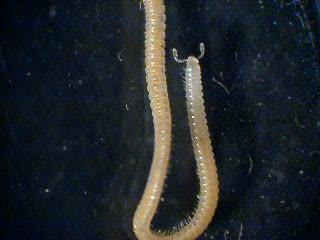The most noticeable thing about millipedes are their number of legs, which lined up along their bodysides step in synchronous "metachronal waves". The acme of legginess in millipedes, and all animals for that matter, is the Californian species Illacme plenipes (literally meaning "in highest fulfillment of feet"). The females have up to an astounding 750 legs, outclassing the males who only have a maximum leg count of 562. The proliferation of legs may be an adaptation for its lifestyle spent burrowing underground or (based on the presence of features like legs with bifurcate claws and other traits known to be associated with rock-climbing in millipedes) enable it to cling tightly to the sandstone boulders found exclusively associated with the species in its habitat
"This relict species is the only representative of its family in the Western Hemisphere. Its closest presumed relative, Nematozonium filum, lives in South Africa and this early relationship was established more than 200 million years ago when the continents coalesced in the landmass Pangaea", said the lead author Dr Paul Marek, from the University of Arizona.
Not only is this species the leggiest animal known on the planet, it also has surprising anatomical features: body hairs that produce silk, a jagged and scaly translucent exoskeleton, and comparatively massive (given its diminutive size) antennae that are used to feel its way through the dark because it lacks eyes. Its mouth, unlike other millipedes that chew with developed grinding mouthparts, is rudimentary and fused into structures that are probably used for piercing and sucking plant or fungal tissues.
This rare and ancient-looking creature's home is California, on the outskirts of Silicon Valley. The species is exceedingly scarce and limited to just a single tiny area near San Juan Bautista, just east of the San Andreas Fault. Based on the known environmental conditions where it lives, the species' probable distribution elsewhere in California was inferred. Yet still restricted to a small geographical range, the analysis indicated other areas of suitability limited to the terrestrial areas on the edge of Monterey Bay eastward to San Juan Bautista and throughout the Salinas Valley. What's unique about this area, and seems to be correlated with the model's area of highest suitability, is the thick layer of fog that accumulates in the area--like soup in a deep bowl. The fog and the species' unique set of features in its habitat (oak forests, sandstone boulders, and fine sandy soil) make this area a special place and certainly deserving of attention as the home of this rare and superlative beast.

This is the habitat of Illacme plenipes. Oak forest in California where I. plenipes<.i> were encountered (composite stitched landscape image of three photos, image sides slightly distorted).
(Photo Credit: Dr. Paul Marek et al.)

This is a movie of Illacme plenipes with 662 legs showing live movement.
(Photo Credit: Dr. Paul Marek)
Source: Pensoft Publishers